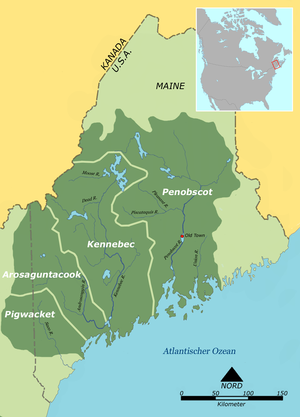Androscoggin people
This article includes a list of references, related reading, or external links, but its sources remain unclear because it lacks inline citations. (May 2023) |

The Androscoggin (Ammoscongon) were an Abenaki people from what are now the U.S. states of Maine and New Hampshire. By the 18th century, they were absorbed by neighboring tribes.
Name
[edit]The name of the Androscoggin is derived from an anglicization of the Abenaki-language term Ammoscongon, which was the name given for the portion of the Androscoggin river from Lewiston Falls northward, as stated by Pere Pole in 1793.[1]
Distribution
[edit]The Ammoscongon once lived in the Androscoggin River watershed, located in present-day southern Maine and northern New Hampshire. Their main village was located in the vicinity of present-day Lewiston, Maine.[citation needed] Together with the Pigwacket near Fryeburg, Maine they formed the southernmost of the Abenaki tribes and were therefore one of the first in contact with the English colonists of New England.
History
[edit]17th century
[edit]In 1675, the Androscoggin took part in King Philip's War. The renowned hunter, trapper, fisherman and guide, Metallak (1727-1847), was a member of the Androscoggin tribe.
18th century
[edit]In 1725, the Androscoggin joined the Pequawket and migrated to the Connecticut River in New Hampshire. They later migrated north to Canada, where they settled in Saint-François-du-Lac, Quebec, present day Abenaki First Nations of Odanak.[2]
Maps
[edit]Maps showing the approximate locations of areas occupied by members of the Wabanaki Confederacy (from north to south):
-
Eastern Abenaki (Penobscot, Kennebec, Pigwacket/Pequawket)
-
Western Abenaki (Arsigantegok, Missisquoi, Cowasuck, Sokoki, Pennacook
See also
[edit]Notes
[edit]- ^ "Pere Pole deposition, Hallowell, 1793". Maine Memory Network. Retrieved 2024-01-04.
- ^ Hodge, Frederick Webb (1907). Handbook of American Indians North of Mexico: N-Z. Washington, DC: US Government Printing Office. p. 229.
References
[edit]- Bruce G. Trigger (ed.): Handbook of North American Indians. Vol. 15. Northeast. Smithsonian Institution Press, Washington D.C. 1978 ISBN 0-16-004575-4
Further reading
[edit]- Starbird, Charles M. The Indians of the Androscoggin Valley: Tribal History, and their Relations with the Early English Settlers of Maine (1928). University of Southern Maine Digital Commons.
External links
[edit]- Abenaki History Archived 2010-04-11 at the Wayback Machine
- Abenaki Council of Odanak




